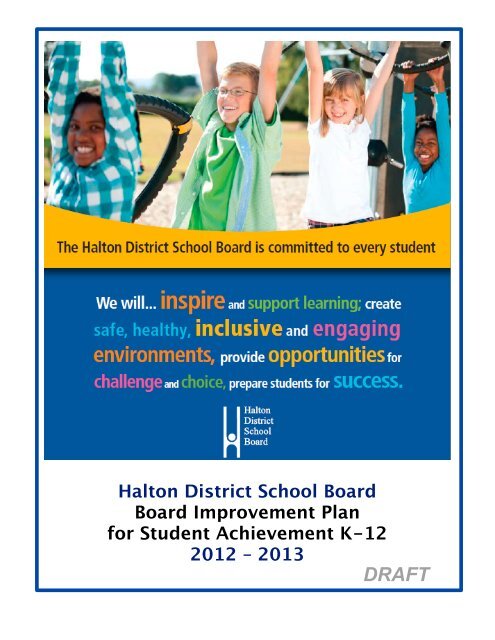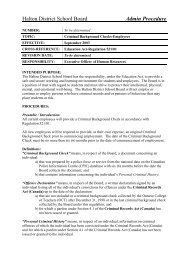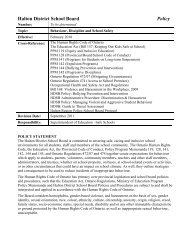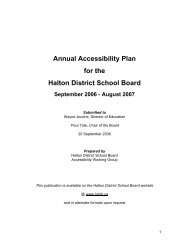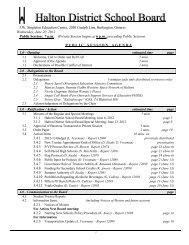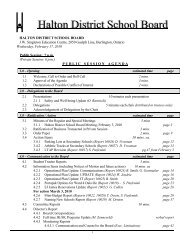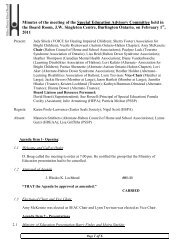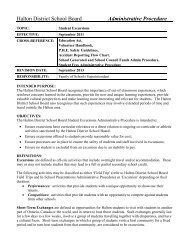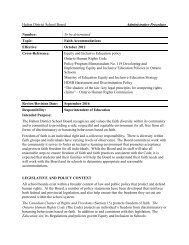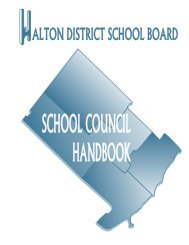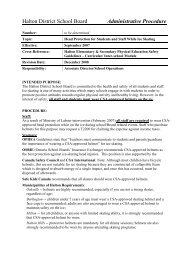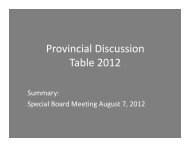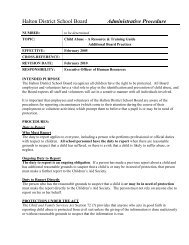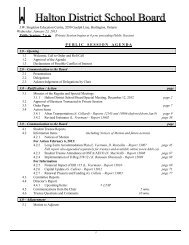hdsb bipsa 2012-2013 - Halton District School Board
hdsb bipsa 2012-2013 - Halton District School Board
hdsb bipsa 2012-2013 - Halton District School Board
Create successful ePaper yourself
Turn your PDF publications into a flip-book with our unique Google optimized e-Paper software.
<strong>Halton</strong> <strong>District</strong> <strong>School</strong> <strong>Board</strong><br />
<strong>Board</strong> Improvement Plan<br />
for Student Achievement K-12<br />
<strong>2012</strong> – <strong>2013</strong><br />
DRAFT
K-12 HDSB <strong>Board</strong> Improvement Plan for Student Achievement<br />
Purpose: Alignment of school, <strong>Board</strong> and Ministry directions with the purpose of improved student<br />
learning, achievement, engagement and the promotion of safe and inclusive learning environments. The<br />
Improvement Plan also provides direction to build capacity and sustainability in the skills and<br />
knowledge of educators.<br />
Focus: A process to assess system/school/classroom needs to develop our HDSB K-12 Improvement<br />
Plan for Student Achievement. Examine the system evidence/data to answer the question<br />
“Did we learn something that suggests we need to refine our focus/actions/strategies?”<br />
Evidence/Data<br />
•The <strong>School</strong> Effectiveness Framework/HDSB Expected Practices<br />
•Quantitative/Qualitative HDSB data<br />
•SIPSA data<br />
•<strong>School</strong> Self-Assessment Analyses<br />
•<strong>District</strong> Review<br />
•Professional Learning Exit Passes, Interviews, Feedback<br />
•Data story for each of the four pillars<br />
Resource: Ministry K-12 BIPSA Improvement Planning Assessment Tool <strong>2012</strong>-<strong>2013</strong><br />
HDSB <strong>Board</strong> Improvement Plan for Student Achievement (K to Grade 12) Page 2
The Process<br />
Work Team Members: Associate Director, Superintendents of Education, System Principals (Student<br />
Success, Safe & Inclusive <strong>School</strong>s, <strong>School</strong> Programs, Leadership and Staff Development, Student<br />
Services, French Language, Community Engagement), and Representation from: Elementary Principals,<br />
Secondary Principals, Community Engagement, <strong>School</strong> Program and Student Services, Research<br />
Department<br />
Phase 1: Work Team<br />
Evaluation of end of year trailing data (e.g., Tell Them From Me survey data, EQAO, credit<br />
accumulation, SSA Analyses) to:<br />
• analyse and reflect on evidence of implementation and impact, and<br />
• recognize accomplishments and gaps to continue cycle of improvement for student achievement<br />
and well-being<br />
Needs Assessment – “How will we use data to identify”:<br />
• Student achievement,<br />
• Address groups of students with specific needs,<br />
• Assess programs and services, and<br />
• Incorporate and respond to perceptual data?<br />
Comprehensive Needs Assessment<br />
• Examine quantitative data provided by research department<br />
• Identify patterns and trends identified through the BIPSA, SIPSAs, <strong>School</strong> Effectiveness Self-<br />
Assessment and <strong>District</strong> Reviews...What are the areas of strength? What is working well?<br />
• Identify achievement gaps for specific students<br />
• Conduct Gap Analysis with respect to coherence among curriculum, instruction, assessment,<br />
resources, professional learning, community and monitoring<br />
• Highlight student achievement data that is of greatest concern and possible contributing factors.<br />
• Connect present programs/services and courses that reduce the achievement gap and enhance<br />
student achievement for all students<br />
• Identify actions (e.g. teaching strategies, assessment practices, collaborative partnerships, transition<br />
processes, education and career planning supports, feedback techniques, curriculum and<br />
monitoring?) in place/needed to support successful outcomes for all students.<br />
In pillar groups, we established the Data Story and SMART Goals for <strong>2012</strong>-<strong>2013</strong><br />
Phase 2: Review Team<br />
Associate Director, Superintendents of <strong>School</strong> Programs, and System Principals<br />
• Review/ Refine pillar data stories and SMART Goals from <strong>Board</strong> Improvement Work Teams<br />
• Make recommendations for:<br />
Targeted Evidence Based Strategies/Actions, Professional Learning Resources, Community<br />
Engagement, Monitoring. Responsibility, Evaluation<br />
• Create a <strong>Board</strong> Improvement Plan draft report for <strong>School</strong> Operations<br />
Step 3: Alignment Process<br />
• <strong>School</strong> Program staff aligns resources and professional learning with SMART Goals<br />
Step 4: <strong>School</strong> Operations<br />
• Review <strong>Board</strong> Improvement Plan draft report with <strong>School</strong> Operations Team<br />
• Finalise recommendations for ALL components of the <strong>Board</strong> Improvement Plan<br />
HDSB <strong>Board</strong> Improvement Plan for Student Achievement (K to Grade 12) Page 3 <strong>2013</strong>-01-12 03n
<strong>School</strong> Self-Assessment (SSA) Data Analysis 2011-<strong>2012</strong><br />
As part of the Needs Assessment process, an analysis of the elementary and secondary <strong>School</strong> Self-Assessments<br />
inform our progress towards the implementation of the Targeted Evidence-Based strategies/actions outlined in our<br />
<strong>Board</strong> Improvement Plan for Student Achievement and drawn from the <strong>School</strong> Effectiveness Framework and/or<br />
HDSB Expected Practices.<br />
<strong>School</strong> Self-Assessments are used to adjust, refine, revise or rethink, Actions/Professional Learning and Resources<br />
outlined in the BIPSA. What we learned from <strong>School</strong> Self Assessments 2011-<strong>2012</strong>:<br />
• The use of leading data is increasing<br />
• Learning cycles are evolving to deeper levels of implementation<br />
• The ‘pillars’ are beginning to merge in practice<br />
• Differentiation is becoming a by-product of assessment as, for and of learning (e.g., know the learner)<br />
• Students have voices<br />
• Engagement strategies are increasingly more evidence-based, intentional and precise<br />
• We are beginning to close the knowing-doing gap.<br />
Identified Next Steps: 2011-<strong>2012</strong> <strong>School</strong> Self-Assessment Analyses<br />
The <strong>School</strong> Effectiveness Framework (2010) will complement the HDSB Expected Practices for the <strong>2012</strong>- <strong>2013</strong><br />
<strong>School</strong> Self-Assessments, <strong>District</strong> Reviews and Improvement Planning. <strong>School</strong>s are moving beyond school level<br />
evidence and focusing on the classroom and student level evidence.<br />
In <strong>2012</strong>-<strong>2013</strong> we will continue to focus on the classroom evidence in the following areas:<br />
• Assessment for, as and of Learning<br />
• Improvement Planning Cycles for Student Achievement and Engagement<br />
• Curriculum, Instruction and Student Learning<br />
Richard Dufour (2006) states, “The best way to<br />
increase student learning is to invest in adult<br />
learning.” We recognize the importance of<br />
providing professional learning opportunities for<br />
teachers and administrators to engage in<br />
collaborative inquiry “that challenges thinking and<br />
practice”.<br />
Through this process, they will examine evidence<br />
of student learning; engage in research to discover<br />
what strategies work best to support the needs of<br />
individual students in their schools.<br />
“Alignment is about structures...Coherence is about mindsets”<br />
Elements of Coherence<br />
1. A small number of ambitious goals<br />
2. A focus on instruction and the student achievement agenda<br />
3. Continuous capacity building around that agenda<br />
Michael Fullan<br />
HDSB <strong>Board</strong> Improvement Plan for Student Achievement (K to Grade 12) Page 4
LITERACY<br />
Needs Assessment:<br />
• EQAO Assessment of Reading, Writing Primary Division<br />
• EQAO Assessment of Reading, Writing Junior Division<br />
• EQAO Ontario Secondary <strong>School</strong> Literacy Test<br />
• PM Benchmark data – 3 year trends<br />
• Report Card data in Reading and Writing Grades 1-9<br />
• Report Card Learning Skills and Work Habits data Grades 1-12<br />
• Tell Them From Me Survey<br />
Concerns:<br />
• Although trends are showing continuous improvement, Primary EQAO Reading<br />
assessment continues to be the lowest area of achievement<br />
• The gender gap in achievement levels in students still exists in all EQAO literacy<br />
assessments for grades 3, 6 and 10<br />
• The gap in achievement levels in students with special education needs still<br />
exists in all EQAO literacy assessments for grades 3, 6 and 10<br />
• The percentage of grade 3 students achieving level 4 in reading increased by 2%<br />
to 10% of our populations<br />
• The percentage of grade 3 students achieving level 4 in writing only increased by<br />
2% to 7% of our population<br />
• The percentage of students below reading level in grades prior to grade 3<br />
• 60% of students receiving and “E” or “G” in “Organization” as indicated in the<br />
Learning Skills and Work Habits on Report Card data in the Applied math, English and science is<br />
60%<br />
Theories behind the baseline: What factors influence the current state?<br />
• Capacity building of all teachers working with ELL students to inform their practice in assessment and instructional<br />
strategies that support English Language Learners<br />
• Teacher expertise in using ongoing formative assessment and feedback to inform focused, intentional and strategic program<br />
planning and instruction that is responsive to every student, including students with special education needs<br />
• The amount of instructional time spent developing oral language skills at the junior grades could be impacting our junior<br />
reading and writing skills<br />
• Professional development opportunities may not have explicitly addressed differentiation strategies to meet specific<br />
learning needs e.g., gender interests/learning styles, respectful task, choice etc.<br />
• As we increase the use of assessment cycles for learning, explicitly stating learning goals, co-constructing success criteria<br />
and involving students in the metacognitive process of self-assessment, we believe students will have greater clarity and<br />
opportunity to achieve the learning goals<br />
• System implementation of explicit teaching and monitoring of Learning Skills and Work Habits<br />
• How well we know our students. Are we responding with intentional, strategic strategies to improve achievement and<br />
engagement?<br />
SMART Goals:<br />
Primary Goal #1<br />
By June <strong>2013</strong>, 75% of all grade 3 students will achieve the provincial standard in reading on the EQAO assessment. This<br />
represents a rise of 2% from the current 73%.<br />
Sub-goals:<br />
• 36% of all grade 3 students with special education needs will achieve the provincial standard in reading on the EQAO<br />
assessment. This represents a rise of 5% from the current 31%.<br />
• 71% of all grade 3 boys will achieve the provincial standard in reading on the EQAO assessment. This represents a rise of<br />
3% from the current 68%.<br />
• 12% of all grade 3 students will achieve level 4 in reading on the EQAO assessment. This represents a rise of 2% from the<br />
current 10%.<br />
Primary Goal #2<br />
By June <strong>2013</strong>, 81% of all grade 3 students will achieve the provincial standard in writing on the EQAO assessment. This<br />
represents a rise of 2% from the current 79%.<br />
Sub-goals:<br />
• 58% of all grade 3 students with special education needs will meet the provincial standard on the EQAO assessment. This<br />
represents a rise of 5% from the current 53%.<br />
• 75% of all grade 3 boys will achieve the provincial standard in writing on the EQAO assessment. This represents a rise of<br />
3% from the current 72%.<br />
• 10% of all grade 3 students will achieve level 4 in writing on the EQAO assessment. This represents a rise of 3% from the<br />
current 7%.<br />
HDSB <strong>Board</strong> Improvement Plan for Student Achievement (K to Grade 12) Page 5 <strong>2013</strong>-01-12 03n
Junior Goal #1<br />
By June <strong>2013</strong>, 84% of all grade 6 students will achieve the provincial<br />
standard in reading on the EQAO assessment. This represents a rise of 2%<br />
from the current 82%.<br />
Sub-goals:<br />
• 50% of all grade 6 students with special education needs will achieve the<br />
provincial standard in reading on the EQAO assessment. This represents<br />
a rise of 4% from the current 46%.<br />
• 16% of all grade 6 students will achieve level 4 in reading on the EQAO<br />
assessment. This represents a rise of 2% from the current 14%.<br />
Junior Goal #2<br />
By June <strong>2013</strong>, 81% of all grade 6 students will achieve the provincial<br />
standard in writing on the EQAO assessment. This represents a rise of 2%<br />
from the current 79%.<br />
Sub-goals:<br />
• 48 % of all grade 6 students with special education needs will achieve<br />
the provincial standard in writing on the EQAO assessment. This<br />
represents a rise of 4% from the current 48%.<br />
• 70% of all grade 6 boys will achieve the provincial standard in<br />
writing on the EQAO assessment. This represents a rise of 3% from<br />
the current 67%.<br />
• 15% of all grade 6 students will achieve level 4 in writing on the<br />
EQAO assessment. This represents a rise of 2% from the current 13%.<br />
Secondary Goal #1<br />
By June <strong>2013</strong>, 97% of fully participating, first time eligible grade 10<br />
students enrolled in academic English classes will be successful on the<br />
OSSLT provincial assessment. This represents a rise of 2% from the<br />
current 95%.<br />
Sub-goals:<br />
• 64% of fully participating, first time eligible grade 10 students enrolled<br />
in applied English classes will be successful on the OSSLT provincial<br />
assessment. This represents a rise of 4%.<br />
• Each school offering LDC English courses will submit through their<br />
literacy coach to the Associate Director an OSSLT provincial assessment target for its cohort of students in LDC<br />
English.<br />
• 64% of all students in grade 9 and 10 applied English, Math, and Science courses will earn a ‘G’ or ‘E’ for their<br />
Organization – Learning Skills and Work Habits. This is a rise of 4%.<br />
• The score for ‘relevance’ on the TTFM survey will rise to 6.0/10, a rise of 0.3<br />
• The score for ‘rigor’ on the TTFM survey will rise to 6.4/10, a rise of 0.3<br />
• The pass rate for Grade 11 workplace English will rise to 88%. This represents an increase of 2.29 percentage<br />
points<br />
• The pass rate for Grade 12 workplace English will rise to 90%. This represents an increase of 2.96 percentage<br />
points
Numeracy<br />
Needs Assessment:<br />
• Grade 3 and 6 EQAO Assessment of Mathematics<br />
• Grade 9 Applied EQAO Assessment of Mathematics<br />
• EQAO Student Questionnaire data<br />
• Locally Developed Programs<br />
• Tell Them From Me student voice data<br />
• Report card data – all strands in mathematics grade 1-8<br />
• Secondary pass rates in mathematics courses<br />
Concerns:<br />
• Overall achievement in mathematics across all divisions<br />
• Lack of Grade 3 goal for achievement in mathematics<br />
• 50% of Grade 3 students responded “most of the time” to “I like math”<br />
yet 89% stated “I try to do my best when I do math activities in class”<br />
on the EQAO student questionnaire<br />
• Loss of 9% re: value added from grade 3 to grade 6 in mathematics<br />
• Achievement gaps for students with special education needs<br />
• Student self-perceptions of math (e.g., “I like math”) in all grades<br />
• Overall pass rates in Gr. 9 to 11 mathematics are consistently lower<br />
than all other subject areas and 3 math credits are a graduation<br />
requirement<br />
Theories behind the baseline: What factors influence the current state?<br />
• Teacher capacity in knowing and learning mathematics for teaching<br />
• Pathway choices by students/parents<br />
• The role of school and system leadership in mathematics: Principal learning teams, networking and support<br />
• System-wide understanding of high-yield strategies for teaching and learning mathematics that impact student<br />
achievement<br />
• Tracking and monitoring of students<br />
• Student engagement and the use of technology<br />
• K-12 numeracy: cross-curricular implementation<br />
• Professional development needs for teachers in knowing and<br />
learning mathematics for teaching<br />
SMART Goals:<br />
Primary:<br />
By June <strong>2013</strong>, 77% of all Gr. 3 students will achieve the provincial<br />
standard on the EQAO Primary Mathematics Assessment. This<br />
represents a rise of 2% from the current 75%.<br />
Sub Goals:<br />
• 15% of Gr. 3 students will achieve level 4. This represents a rise of<br />
2% from the current 13%.<br />
• 40% of Gr. 3 students with special education needs will achieve the<br />
provincial standard. This represents a rise of 2% from the current<br />
38%.<br />
Junior:<br />
By June <strong>2013</strong>, 68% of all grade 6 students will achieve the provincial<br />
standard on the EQAO Junior Mathematics Assessment. This<br />
represents a rise of 2% from the current 66%.<br />
Sub Goals:<br />
• 16% of Gr. 6 students will achieve level 4. This represents a rise of<br />
2% from the current 14%.<br />
• 28% of Gr. 6 students with special education needs will achieve the<br />
provincial standard. This represents a rise of 2% from the current<br />
26%.<br />
EQAO Junior Student Questionnaire Results will not be available for<br />
<strong>2012</strong>-<strong>2013</strong>. This data should be considered for <strong>2013</strong>-2014.<br />
I like mathematics, I am good at mathematics, I am able to answer difficult questions, I ask for help, I think about the<br />
steps I will use to solve the problem, Use of manipulatives<br />
HDSB <strong>Board</strong> Improvement Plan for Student Achievement (K to Grade 12) Page 7
Grade 9 Applied Mathematics<br />
By June <strong>2013</strong>, 56% of all students in Gr. 9 Applied math will achieve the provincial<br />
standard on the EQAO Grade 9 Applied Mathematics Assessment. This represents<br />
a rise of 2% from the current 54%.<br />
Sub<br />
<br />
goals:<br />
• 50% of students with special education needs in Gr. 9 Applied math will<br />
achieve the provincial standard. This represents a rise of 3% from the<br />
<br />
current 47%.<br />
<br />
<br />
<br />
<br />
<br />
<br />
<br />
<br />
<br />
Grade 9 Locally Developed Math Course<br />
By June <strong>2013</strong>, 78% of students enrolled in Grade 9 Locally Developed Mathematics<br />
Course will earn a credit as reflected in their final mark. This represents a rise of 10%<br />
from the current 68%.<br />
Pass Rates in Locally Developed<br />
Gr. 9 Math 3 yr. Rolling Average<br />
Grade Grade 9 to 912 Locally Math Developed Courses Math Course<br />
By June <strong>2013</strong>, 98% of grade 9 students enrolled in math courses will pass. This<br />
represents <br />
a rise of 2% from the current 96%.<br />
<br />
54% of grade 9 students enrolled in math courses will identify they are<br />
<br />
“intellectually engaged” as measured on the TTFM survey. This represents a rise<br />
<br />
of 2% Grade from 9 to the 12 Math current Courses 52%.<br />
<br />
94% <br />
of grade 10 students enrolled in math courses will pass. This represents a<br />
rise of 2% from the current 92%.<br />
<br />
<br />
48% of grade 10 students enrolled in math courses will identify they are<br />
<br />
“intellectually <br />
engaged” as measured on the TTFM survey. This represents a rise<br />
of 2% from the current 46%.<br />
<br />
96% <br />
of grade 11 students enrolled in math courses will pass. This represents a rise of 3% from the current 93%. 45% of grade<br />
11 students enrolled in math courses will identify they are “intellectually engaged” as measured on the TTFM survey. This<br />
<br />
represents a rise of 2% from the current 43%.<br />
<br />
<br />
53% of grade 12 students enrolled in math courses will identify they are “intellectually engaged” as measured on the TTFM<br />
survey. <br />
This represents a rise of 2% from the current 51%.<br />
<br />
<br />
<br />
<br />
HDSB <strong>Board</strong> Improvement Plan for Student Achievement (K to Grade 12) Page 8
Safe and Inclusive <strong>School</strong>s<br />
Needs Assessment:<br />
• Tell Them From Me Survey data<br />
• Learning Skills and Work Habits<br />
Concerns:<br />
• Data from Grades 6-10 presented concerns regarding the decreased feelings of safety, belonging, advocacy, and increased reports of<br />
bullying behaviour.<br />
• Varying ability, at the school level, to drill down into their TTFM Data<br />
Elementary Students:<br />
• When asked whether they have someone at school that consistently provides encouragement and can be turned to for<br />
advice, 5.2/10 elementary students said that they did.<br />
• 85% of elementary students feel accepted and valued by their peers and by others at their school.<br />
• When asked to report on their feelings of safety at school, 90% elementary students<br />
reported feeling safe.<br />
• 23% of elementary students report experiencing moderate to severe bullying in the<br />
month prior to answering the TTFM survey.<br />
Secondary Students:<br />
• When asked whether they have someone at school that consistently provides<br />
encouragement and can be turned to for advice, 2.5/10 secondary students said that<br />
they did.<br />
• 74% of secondary students feel accepted and valued by their peers and by others at<br />
their school.<br />
• When asked to report on their feelings of safety at school, 8.2/10 secondary students<br />
reported feeling safe.<br />
• 18% of secondary students report experiencing moderate to severe bullying in the<br />
month prior to answering the TTFM survey.<br />
Theories behind the baseline: What factors influence the current state?<br />
• Strategic and intentional school and classroom focus on creating safe, caring, and<br />
inclusive learning environments as the foundation of their work.<br />
• Teachers’ holistic knowledge and understanding of their learners.<br />
• Effective use of strategies that build safe, caring, and inclusive learning<br />
environments.<br />
• Using multiple sources of data to identify which students do not feel they have an<br />
advocate at school, who do not feel safe, and do not have a sense of belonging in<br />
their school community.<br />
• Strategic response plan when we do know which students are in need of support<br />
• Explicit teaching of the skills required to contribute to safe, caring, and inclusive<br />
learning environments (e.g., conflict resolution skills, self-regulation, social skills,<br />
collaboration).<br />
• Professional learning and resources to support teachers in acquiring the skills and<br />
strategies that will help them to know, understand and use practices that build safe,<br />
caring, and inclusive environments within the context of their programs/courses<br />
SMART Goals:<br />
By June, <strong>2013</strong>:<br />
Elementary Students:<br />
• 87% of elementary students will report “a positive sense of belonging” as measured on<br />
the Tell Them From Me survey. This represents a rise of 2% from the current 85%.<br />
• 93% of students will report they “feel safe at school” as measured on the Tell Them<br />
From Me survey. This represents a rise of 3% from the current 90%.<br />
• All students will obtain a score of 5.6/10 on the Tell Them From Me survey measure of having “someone at<br />
school that consistently provides encouragement and can be turned to for advice”. This represents a rise of<br />
0.8/10 from the current 4.8/10.<br />
• 21% of students will report they have “experienced bullying in the month prior” to participating in the Tell<br />
Them From Me survey. This represents an increase of 2% from the current 23%.<br />
HDSB <strong>Board</strong> Improvement Plan for Student Achievement (K to Grade 12) Page 9
Secondary Students:<br />
• 75% of students will report a positive sense of belonging on the Tell Them From Me survey. This represents a<br />
rise of 3% from the current 72%.<br />
• 88% of students will report they “feel safe at school” on the Tell Them From Me survey. This represents a<br />
rise of 2% from the current 86%.<br />
• All students will obtain a score of 2.9/10 on the Tell Them From Me survey measure of “having someone at<br />
school that consistently provides encouragement and can be turned to for advice”. This represents a rise of<br />
0.4/10 from the current score is 2.5/10.<br />
• 17% of students will report they have “experienced bullying in the month prior” to participating in<br />
the Tell Them From Me survey. This represents an decrease of 2% from the current 19%.<br />
HDSB <strong>Board</strong> Improvement Plan for Student Achievement (K to Grade 12) Page 10
Pathways<br />
Data:<br />
• TTFM - relevance, valuing school outcomes<br />
• Learning Skills and Work Habits – Self Regulation, Initiative<br />
• Credit Accumulation<br />
Concerns:<br />
• Student engagement as reflected TTFM is 50% – motivation and interest in the learning and the Learning<br />
Skill and Work Habits – Initiative<br />
• Learning Skills trends<br />
• Student involvement in setting goals, reflecting on strengths and needs, interests, planning for improvement –<br />
Learning Skills and Work Habit – Self-regulation<br />
• Students not planning to complete high school – 18% of all students, 15% of females, 21% of males<br />
• Approximately 20 % of students are not on track to graduate as measured by Grade 10 credit accumulation<br />
• <strong>School</strong> Self-Assessment evidence is focused on grade 9 and 10 data, need more evidence with respect to<br />
students in grades 11 and 12<br />
Theories behind the baseline: What factors influence the current state?<br />
• The extent we explicitly teaching Self Regulation<br />
• The value placed on learning skills in intermediate and senior grades<br />
• Understanding of what self-regulation looks like for students at different ages and stages<br />
• The link between self-regulation and achievement<br />
• Students’ perception of the relevance in the work they are doing<br />
• Contextual learning activities consistently applied in the program planning cycles for learning to engage<br />
students in making real world connections and greater awareness of careers associated with the learning in<br />
the classroom.<br />
• Student engagement in the co-construction of success criteria to promote clarity of the learning goals and<br />
expectations, improved decision-making and goal setting.<br />
• Understanding that differentiated instruction and student voice are embedded in instruction, assessment and<br />
learning cycles<br />
Smart Goals<br />
By June <strong>2013</strong>,<br />
• 81% of grade 10 students will have accumulated 16<br />
credits by the end of grade 10. This represents an increase<br />
of 0.4% from the current 80.6%.<br />
• 70% of grade 10 students will indicate that they value<br />
school outcomes as measured by the TTFM survey. This<br />
represents a 2% increase from the current 68%.<br />
• 63% of grade 11 students will indicate that they value<br />
school outcomes as measured by the TTFM survey. This<br />
represents a 2% increase from the current 61%.<br />
• All secondary students will obtain a score of 6/10 on the<br />
Tell Them From Me survey measure of Relevance. The<br />
current score is 5.7/10.<br />
• 76.5 % of all students from grade 1 through 12 will achieve good or excellent on the Self-<br />
Regulation achievement on the Final Report card. This represents a rise of 1.9% from the current<br />
74.6%<br />
HDSB <strong>Board</strong> Improvement Plan for Student Achievement (K to Grade 12) Page 11
Targeted Evidence-Based Strategies/Actions<br />
If we implement the following practices in every school, every classroom, for every student we believe we will improve<br />
student achievement and engagement. These actions will improve the goals of Literacy, Numeracy,Safe & Inclusive <strong>School</strong>s<br />
and Pathways for every student.<br />
Component #3 – Assessment and Evaluation Component #2 – Instructional Leadership<br />
(HDSB Expected Practices)<br />
(HDSB Expected Practices)<br />
OR<br />
OR<br />
Component #1 –Assessment for, as and of Component #2 - <strong>School</strong> and Classroom<br />
Learning(<strong>School</strong> Effectiveness Framework) Leadership (<strong>School</strong> Effectiveness<br />
Framework)<br />
Indicator 1.1 - Students and teachers<br />
share a common understanding of the<br />
learning goals and related success<br />
criteria.<br />
Indicator 1.2 - During learning,<br />
students receive ongoing, descriptive<br />
feedback based on the success criteria<br />
from the teacher and from peers.<br />
Indicator 1.3 - Students are taught, and<br />
regularly use self-assessment skills to<br />
monitor their progress toward<br />
achieving learning goals, and to set<br />
their own learning goals within the<br />
context of the Ontario curriculum and/<br />
or Individual Education Plan (IEP).<br />
Indicator 1.4 - Assessment tasks are<br />
aligned with the curriculum,<br />
collaboratively developed by teachers<br />
and the resulting demonstrations of<br />
student learning analyzed to ensure<br />
consistency with success criteria.<br />
Indicator 1.5 - A variety of valid and<br />
reliable assessment data is used by<br />
students and teachers to continuously<br />
monitor learning, to inform instruction<br />
and assessment and to determine next<br />
steps.<br />
Indicator 1.6 - Assessment of learning<br />
provides evidence for evaluating the<br />
quality of student learning at or near<br />
the end of a period of learning.<br />
Indicator 1.7 - Ongoing<br />
communication is in place to allow<br />
students, teachers and parents to<br />
effectively monitor student learning.<br />
Indicator 2.1 - Collaborative<br />
instructional leadership builds<br />
capacity to strengthen and enhance<br />
teaching and learning.<br />
Indicator 2.2 - Processes and<br />
practices are designed to deepen<br />
content knowledge and refine<br />
instruction to support student<br />
learning and achievement.<br />
Indicator 2.3 - Organizational<br />
structures are coherent, flexible and<br />
respond to the needs of students.<br />
Indicator 2.4 - Job-embedded and<br />
inquiry-based professional learning<br />
builds capacity, informs instructional<br />
practice and contributes to a culture<br />
of learning.<br />
Indicator 2.5 - Staff, students and<br />
school community promote and<br />
sustain student well-being and<br />
positive student behaviour in a safe<br />
and healthy learning environment.<br />
Components #1 – Student Learning and<br />
Achievement & Component #4 – Curriculum<br />
and Instructional Strategies<br />
(HDSB Expected Practices)<br />
OR<br />
Component #4 - Curriculum, Teaching and<br />
Learning (<strong>School</strong> Effectiveness<br />
Framework)<br />
Indicator 4.1 - A culture of high<br />
expectations supports the belief that all<br />
students can learn, progress and<br />
achieve.<br />
Indicator 4.2 - A clear emphasis on high<br />
levels of achievement in literacy and<br />
numeracy is evident throughout the<br />
school.<br />
Indicator 4.3 - Teaching and learning<br />
incorporates 21st Century content,<br />
global perspectives, learning skills,<br />
resources and technologies.<br />
Indicator 4.4 - Learning is deepened<br />
through authentic, relevant and<br />
meaningful student inquiry.<br />
Indicator 4.5 - Instruction and<br />
assessment are differentiated in<br />
response to student strengths, needs and<br />
prior learning.<br />
Indicator 4.6 - Resources for students<br />
are relevant, current, accessible and<br />
inclusive.<br />
Indicator 4.7 - Timely and tiered<br />
interventions, supported by a team<br />
approach, respond to individual student<br />
learning needs.<br />
HDSB <strong>Board</strong> Improvement Plan for Student Achievement (K to Grade 12) Page 12
CROSS PILLAR<br />
Resources<br />
Professional Learning<br />
If we use the following resources we will make progress towards If we participate in the following professional learning we will<br />
the achievement of our actions and goals. These resources will make progress towards the achievement of our actions and goals.<br />
support the goals of Literacy, Numeracy, Safe & Inclusive These learning opportunities will support the goals of Literacy,<br />
<strong>School</strong>s and Pathways for every student.<br />
Numeracy, Safe & Inclusive <strong>School</strong>s and Pathways for every<br />
student.<br />
• Growing Success<br />
• <strong>School</strong> Effectiveness Framework Resources<br />
• LNS Resources aligned to <strong>School</strong> Effectiveness<br />
Framework<br />
• Job-embedded professional learning includes co-planning,<br />
co-learning, and the collaborative analysis of student work to<br />
inform next steps to improve student achievement and<br />
engagement (e.g., Coaches, Learning Resource Teachers,<br />
<strong>School</strong> divisions/grade teams/subject departments)<br />
• Assessment, Evaluation and Reporting GAINS<br />
(Growing Success resources and professional learning)<br />
• Professional Learning Cycles (Plan, Act, Observe,<br />
Reflect)<br />
• TLCP Monograph<br />
• Collaborative Teacher Inquiry<br />
• Student Inquiry Monograph<br />
• Learning for All<br />
• ELL GAINS<br />
• Kindergarten GAINS<br />
• Re-engagement Strategy<br />
• Ontario Education Resource Bank (OERB)<br />
• Student Success Differentiated Instruction Professional<br />
Learning Strategy<br />
• Accessibility for Ontarians with Disabilities Act (AODA)<br />
• Monthly Elementary Administrator <strong>School</strong> Program<br />
Update<br />
Human<br />
<strong>School</strong> Leadership Teams<br />
Instuctional Program Leaders, Consultants, Coordinators,<br />
Student<br />
Services Area Managers<br />
• <strong>School</strong>-based Inquiry Learning (e.g., Teacher Inquiry,<br />
Student Inquiry, T-LCP, and/or Professional Learning Cycles)<br />
• <strong>School</strong>-based Staff Learning<br />
• <strong>School</strong> Program staff work in schools with administrators,<br />
school leadership teams and teachers to provide<br />
differentiated professional learning opportunities in response<br />
to the goals/needs of individual schools identified through<br />
the <strong>School</strong> Self-Assessment and <strong>School</strong> Improvement<br />
Planning processes<br />
• Ministry Inquiry Initiative networks (e.g., Collaborative<br />
Inquiry in Learning Mathematics, Early Primary Years<br />
Collaborative Inquiry, Assessment for Learning<br />
Collaborative Inquiry, Middle Years Collaborative Inquiry,<br />
Adolescent Literacy, OFIP, SIM, etc.)<br />
• <strong>District</strong> Review Professional Development (Jan/Mar)<br />
• Family of <strong>School</strong>s System Learning:<br />
October: Bring I.T./e-learning<br />
November: Numeracy/Mathematics<br />
January: Improvement Planning/SIPSA Monitoring/Safe &<br />
Inclusive <strong>School</strong>s<br />
February: Mental Health<br />
March: Improvement Planning and SSAs<br />
April: Numeracy/Mathematics<br />
• Family of <strong>School</strong>s self-directed professional learning<br />
• New Teacher Induction Program Mentoring and Networks<br />
• Administrator Mentoring and Networks<br />
• Building Leadership and Learning Capacity series<br />
Presenters: Dr. Douglas Willms, Mawi Asgedom<br />
Student Success Teachers (7-12)<br />
Special Education Resource Teachers<br />
ESL Teachers<br />
Growing Success Subject Councils (9-12)<br />
HDSB <strong>Board</strong> Improvement Plan for Student Achievement (K - 12) Page 13
Resources<br />
If we use the following resources we will make progress towards the<br />
achievement of our actions and goals. These resources will support the goals of<br />
Literacy, Numeracy, Safe & Inclusive <strong>School</strong>s and Pathways for every student.<br />
• HDSB Reading brochure –Every Student Can Learn to Read<br />
• HDSB PM Benchmark/DRA Administration Cards<br />
• The Art of Guided Reading (HDSB video)<br />
• Literacy Place (primary), Literacy In Action (junior), Nelson<br />
Literacy (intermediate), Envol (primary), Litteratie en Action<br />
(4-8)<br />
• HDSB resource – Linking Literacy Place and EQAO<br />
• HDSB resource – Linking Literacy in Action and EQAO<br />
• RAZ kids (primary reading on-line resource)<br />
• Book Flix<br />
• Book Flood (Independent Reading Texts ENG 1P/1L/2P/2L)<br />
• E-Learning/Blended Learning courses<br />
• Multi-cultural Collection (FDK CHATT conference)<br />
• Lexia Program (self-contained LD classes)<br />
Ministry<br />
• Guides to Effective Literacy Instruction (primary, junior)<br />
• Primary Reading Discussion Paper (webcast)<br />
• eWorkshop (primary/junior English; primary French Immersion)<br />
• Literacy GAINS (Grades 7 – 12)<br />
• Think Literacy Library (Grades 7 – 12)<br />
• Adolescent Literacy Guide<br />
• A Guide to Reflective Practice (Core French)<br />
• Prologue (French Immersion and extended French)<br />
• Supporting Boys’ Literacy<br />
• Summary of Results and Strategies for Teachers (EQAO Primary<br />
and Junior Divisions)<br />
• EQAO Educator Resources (Gr. 3, 6, 10)<br />
• Reading and Writing with Your Child Parent Resource<br />
Human<br />
• Itinerant Resource Teacher: Assessment (K-2)<br />
• Learning Resource Teachers (K-2)<br />
• Literacy Coaches (9 – 12)<br />
Resources<br />
• Pathways Planner (grades 7 and 8)<br />
• MyBlueprint Education planner<br />
• <strong>School</strong> to Career<br />
• Pathways Program Option Resource<br />
• Guide to Secondary <strong>School</strong><br />
• Pathways, Programs and Initiatives<br />
• <strong>Halton</strong> Industry Education Council (HIEC)<br />
• Integrated Learning in the Classroom<br />
• Integrated Curriculum: Increasing relevance while<br />
maintaining accountability<br />
• Choices into Action<br />
• Student Success Differentiated Instruction Professional<br />
Learning Strategy<br />
LITERACY<br />
Professional Learning<br />
If we participate in the following professional learning we will make progress<br />
towards the achievement of our actions and goals. These learning opportunities<br />
will support the goals of Literacy, Numeracy, Safe & Inclusive <strong>School</strong>s and<br />
Pathways for every student.<br />
• Literacy Institutes for Elementary Teachers – learning series<br />
focused on Running Records, Miscue Analysis and responsive<br />
targeted guided instruction in primary literacy<br />
• Elementary Administrator Literacy Learning Team – series<br />
focused on 13 Parameters: A Literacy Leadership Toolkit to<br />
support administrators in leading literacy in their school<br />
• PM Benchmark/DRA Workshops – administration of diagnostic<br />
assessments<br />
• Learning Resource Teachers (32 schools) – build capacity in<br />
effective literacy instruction/intervention in K-2 classrooms<br />
• Levelled Literacy Intervention Network – implementation sessions<br />
for administrators/LRTs (10 schools) and <strong>School</strong> Program staff<br />
• Study Work Study teachers – ongoing collaborative analysis of<br />
students at work with classroom teachers (primary literacy)<br />
• System Implementation and Monitoring (SIM) Primary Literacy<br />
Networks – focus on the use of data to identify learning needs for<br />
small group instruction (e.g., Running Records, observation of<br />
reading behaviours); the four roles of the literate learner; flexible,<br />
small grouping to differentiate instruction to support student<br />
learning<br />
• System Implementation and Monitoring (SIM) French Immersion/<br />
English networks – co-planning cross curricular big ideas;<br />
implementation of literacy strategies to develop thinking and<br />
accountable talk; teachers will collect and analyse evidence in<br />
assessment for and as learning to inform instruction<br />
• Literacy Coaches (9-12) – collaborative learning, co-planning<br />
and/or co-teaching to inform instructional practices to meet the<br />
needs of students<br />
PATHWAYS<br />
Professional Learning<br />
• Boys’ Writing Achievement and Engagement Inquiry –<br />
Non-fiction reading and writing, Information,<br />
Communication Technology<br />
• 7-12 Inquiry Projects – continued focus on Assessment for,<br />
as and of Learning in-services – focus on student knowing<br />
themselves as learners and building self-efficacy<br />
• Contextualized Learning Professional development<br />
• Teacher training to support skills development (e.g., kiln,<br />
wood shop, NTIP, community connections)<br />
• Classroom health and safety training (e.g., design and<br />
technology)<br />
HDSB <strong>Board</strong> Improvement Plan for Student Achievement (K to Grade 12) Page 14
Resources<br />
If we use the following resources we will make progress towards the<br />
achievement of our actions and goals. These resources will support the goals of<br />
Literacy, Numeracy, Safe & Inclusive <strong>School</strong>s and Pathways for every student.<br />
• HDSB Overall Expectation Continuums (K-8)<br />
• HDSB resource – Linking Core Resources and EQAO<br />
• HDSB Numeracy Strategy<br />
Ministry<br />
• Guides to Effective Instruction in Mathematics (K-6)<br />
• Math GAINS (K-12)<br />
(e.g., curricular continuums, mathematical processes resources)<br />
• Targeted Implementation and Planning Supports (Gr. 7-12)<br />
• Paying Attention to Mathematics<br />
(7 Principles for Improvement in Mathematics, K-12)<br />
• K-12 Supporting Numeracy<br />
• Literacy and Numeracy Secretariat Math Resources<br />
• Gap Closing Junior/Intermediate: (Number Sense)<br />
• Gap Closing Intermediate/Senior (Number Sense and Algebra)<br />
• Summary of Results and Strategies for Grade 9 Mathematics<br />
• Summary of Results and Strategies for Teachers (Primary and<br />
Junior Divisions)<br />
• EQAO Educator Resources (Gr. 3, 6, 9)<br />
• On-line Math Homework Help (Gr. 7-10)<br />
• Licensed software (e.g., Fathom, Tinkerplots, Geometer’s<br />
Sketchpad),<br />
• Statistics Canada Learning Resources<br />
• Doing Math with Your Child Parent Resource (K-6)<br />
Human<br />
• Math Coaches (Gr. 4-10)<br />
• Student Work Study Teachers (junior)<br />
Resources<br />
• Promoting Positive <strong>School</strong> Climate: A Resource for <strong>Halton</strong><br />
<strong>School</strong>s<br />
• EQUITY Continuum<br />
• Bullying Prevention and Intervention, Guide & Brochure<br />
• Equity through Inclusion: An Administrator’s Handbook<br />
• Equity through Inclusion: An Educator’s Handbook<br />
• English Language Learners with Special Education Needs<br />
• Aboriginal Perspectives: A Guide to the Teacher’s Toolkit<br />
• A brief Guide to Understanding Aboriginal Cultures in <strong>School</strong>s<br />
Human<br />
• Safe <strong>School</strong>s Action Teams/Advisory Group<br />
• Safe <strong>School</strong>s Social Workers, Child and Youth Counsellors,<br />
<strong>School</strong>-based Social Workers (9-12)<br />
• Developmental Assets Trainers<br />
• HMC Youth Settlement Workers<br />
• ABA Facilitators<br />
• Public Health Nurse/Mental Health Liaison Nurse<br />
• Mental Health Lead<br />
• Interpreters<br />
• Elders/Aboriginal Education Advisory Committee<br />
• ESL Advisory Team<br />
NUMERACY<br />
Professional Learning<br />
If we participate in the following professional learning we will make progress<br />
towards the achievement of our actions and goals. These learning opportunities<br />
will support the goals of Literacy, Numeracy, Safe & Inclusive <strong>School</strong>s and<br />
Pathways for every student.<br />
• Numeracy Learning Networks -<br />
Early Primary Collaborative Inquiry (Primary)<br />
Collaborative Inquiry in Learning Mathematics (Junior)<br />
System Implementation and Monitoring (SIM – Junior)<br />
Middle Years Collaborative Inquiry in Mathematics<br />
Focus of Learning will be to:<br />
→<br />
→<br />
→<br />
→<br />
Safe & Inclusive <strong>School</strong>s<br />
improve student achievement in mathematics,<br />
promote positive attitudes toward mathematics,<br />
build capacity in understanding learning mathematics for<br />
teaching, and/or<br />
identify and implement effective mathematics instruction.<br />
• Math Coaches (4-12) - build shared understanding of effective<br />
mathematics instruction; design a responsive mathematics learning<br />
environment; provide assessment and evaluation in mathematics<br />
that supports student learning; facilitate access to mathematics<br />
learning resources<br />
• Elementary Administrator Numeracy Learning Team – 5 Part<br />
Series to build understanding of effective mathematics instruction;<br />
professional learning in mathematics; facilitate access to<br />
mathematics learning resources; coordinate and strengthen<br />
leadership in mathematics<br />
• Study Work Study teachers (15 schools) – ongoing collaborative<br />
analysis of students at work with junior classroom teachers<br />
• Family of <strong>School</strong>s Learning sessions K-12 – areas of focus:<br />
Intervention, Resources, Administrator Look Fors, integrating<br />
Technology, developing content knowledge for teaching and<br />
learning mathematics<br />
• Numeracy Institutes for Elementary Teachers – 5 part series to<br />
support development of knowing and learning mathematics for<br />
teaching: developing teacher pedagogical content knowledge and<br />
understanding how students learn mathematics<br />
• System-wide Numeracy PA Day – choice of professional learning<br />
resources provided to schools to support school numeracy learning<br />
Professional Learning<br />
• Instructional program leaders support the <strong>School</strong> Improvement<br />
Planning needs analysis, goals and action plans (e.g., ELL, FNMI,<br />
LGBT, SES)<br />
• <strong>School</strong> teams use professional learning cycles/TLCPs to provide<br />
engaging and relevant tasks which provide opportunity for student<br />
voice, inclusive and equitable learning environments, fair and<br />
equitable assessment and evaluation tools<br />
• Training in Collaborative Problem Solving and Restorative<br />
Practices<br />
• Safe <strong>School</strong>s workers provide support for Developmental Assets<br />
• Data analysis of Tell Them From Me Survey – use of research<br />
associated with the findings<br />
• Mental Health Awareness Training<br />
• Violent Threat Risk Assessment<br />
• Police/<strong>School</strong> <strong>Board</strong> Protocol Training<br />
• Accessibility Awareness<br />
• Equity and Cultural Proficiency<br />
• GSA and Elementary Pride<br />
• Newcomer Strategy<br />
• Aboriginal Perspectives<br />
• Nutritional Standards<br />
• Equity Lenses<br />
HDSB <strong>Board</strong> Improvement Plan for Student Achievement (K - 12) Page 15
Community Engagement<br />
If we engage our community partners in supporting our improvement<br />
plans we will make progress to the achievement of our actions and<br />
goals.<br />
Communicating<br />
• <strong>School</strong> Improvement Plan (SIP) is shared with <strong>School</strong> Council<br />
• SEAC consultation<br />
• Websites: <strong>Board</strong>/<strong>School</strong> /Classroom, <strong>School</strong> to Career, Ontario<br />
Youth Apprenticeship Program, MyBlueprint Education planner<br />
• Parent/Student/Teacher Interview/Conferences<br />
• Program nights, Family Math/Literacy nights<br />
• Growing Success Parent communication e.g., “How to Read this<br />
Progress Report Card” Brochure<br />
• Supporting your Child's Learning through Assessment,<br />
Evaluation and Reporting– 20 languages<br />
• Interpreters available upon request<br />
• Transitions into school opportunities e.g., Kindergarten<br />
orientations<br />
• Student Agendas<br />
• Accessibility for Ontarians with Disabilities Act (AODA)<br />
Volunteering<br />
• Community volunteers are used effectively to support SIP goals/<br />
actions<br />
• VEX, First Robotics, Skills Olympics etc. volunteers<br />
• ECO <strong>School</strong>s<br />
Learning At Home<br />
• Learning opportunities, resources and supports are provided to<br />
help parents support student learning, parent-teacher-student<br />
communication<br />
• HDSB Homework Guidelines<br />
• Homework Help Line Grade 7 – 10 Mathematics<br />
• EQAO Parent Resources<br />
• LINK (Learn, Interface, Network & Knowledge)<br />
Decision Making<br />
• Parent surveys are used in the data analysis and needs assessment<br />
if available<br />
• Special Education on-line parent Survey<br />
• Pathways Program Information for Parents<br />
Collaborating with Community<br />
• Newcomer centers - partnership with <strong>Halton</strong> Multicultural Center<br />
and Youth Settlement Workers<br />
• Equity and Inclusive Education Advisory Committee<br />
• HDSB Bullying Prevention brochure<br />
• <strong>Halton</strong> Partners in Safe <strong>School</strong>s – <strong>Halton</strong> Regional Police<br />
• Special Education Community consultation evening<br />
• ESL and IEP in-services for parents<br />
• Pathways information evenings<br />
• Parent Involvement Committee (PIC) conference<br />
• <strong>Halton</strong> Learning Foundation<br />
• Our Kids Network<br />
• <strong>Halton</strong> Food For Thought<br />
• Collaboration with local mental health agencies (SSLI)<br />
• Outdoor Education Advisory Committee<br />
• Conservation <strong>Halton</strong><br />
• Royal Botanical Gardens<br />
• The Centre for Skills Development<br />
Parenting<br />
• SIP goals and actions are reflected in home communications such<br />
as newsletters, program nights, websites, student work<br />
displays)<br />
• Assist families in understanding child and adolescent development<br />
•Parent Involvement Committees<br />
•Assist schools in understanding/supporting families<br />
Monitoring<br />
If we engage in ongoing assessment and monitoring of our actions and<br />
goals we will improve students achievement and engagement.<br />
Ongoing<br />
• Principals use Planning Cycle data/TLCP data/ESAT data to<br />
inform progress towards the achievement of SIPSA goals<br />
• Classroom teachers use Planning Cycle data/TLCP data/Reading<br />
assessment data to inform instruction, progress towards<br />
achievement and next steps for continued improvement<br />
• Running Records are “10 days current” in primary classrooms<br />
• Data about professional learning are to ascertain impact on<br />
instructional capacity, student learning and professional learning<br />
needs (e.g., information is collected on professional learning<br />
supports provided to teachers the number of participating teachers,<br />
the impact on classroom instructional practice and the resulting<br />
growth in student achievement)<br />
• Student Self-Assessment, exit passes<br />
• Observation and documentation<br />
• Taking Stock - Student Success Tracking and Monitoring<br />
• Common Assessment Tool (<strong>Halton</strong>)<br />
• Ministry Assessment Tool for <strong>Board</strong> and <strong>School</strong> Improvement<br />
Planning<br />
• Department Self-Assessment (Secondary)<br />
• Surveys - student and teacher<br />
Fall<br />
• Evaluation of TTFM/EQAO goals/data<br />
•<strong>School</strong> Self-Assessments Analysis Reports released<br />
•September Family of <strong>School</strong>s - identification of system Strengths/Next<br />
Steps from SSA System Analysis and <strong>School</strong> Improvement Plan<br />
Evaluations<br />
•Draft SIPSA development in schools and submitted to Superintendents<br />
(October)<br />
•Safe <strong>School</strong> Action Plans developed by each school (October)<br />
•Reading Data collected to inform instruction<br />
English: PM Benchmark (primary readers), DRA (junior/intermediate)<br />
French: GB Plus (primary), Lecture Rapide (junior/intermediate)<br />
•Data walls for monitoring student progress in reading<br />
•Superintendent of <strong>School</strong>s visits include discussion of <strong>School</strong><br />
Improvement Plans for Student Achievement<br />
•Progress Report data for elementary schools<br />
Winter<br />
•Family of <strong>School</strong>s Administrator discussion, sharing and feedback of<br />
goals, actions and methods of monitoring<br />
•<strong>District</strong> Reviews (where applicable)<br />
•Achievement data and Learning Skills data from semester 1 reporting<br />
Spring<br />
•<strong>School</strong>s use their Improvement Plan and SEF/HDSBExpected<br />
Practices to conduct a <strong>School</strong> Self Assessment<br />
•<strong>School</strong> Self Assessment submitted annually (May)<br />
•Superintendent of <strong>School</strong>s visits include discussion of <strong>School</strong><br />
Improvement Plans, <strong>School</strong> Self-Assessment/<strong>District</strong> Review Strengths<br />
and Next Steps<br />
•<strong>School</strong> Effectiveness Teacher and Parent/Guardian Survey<br />
•Tell Them From Me Survey<br />
•<strong>District</strong> Review (where applicable)<br />
•Reading Data collected to inform instruction<br />
English: PM Benchmark (primary readers), DRA (junior/intermediate)<br />
French: GB Plus (primary), Lecture Rapide (junior/intermediate)<br />
•Achievement Data and Learning Skills Data collected from semester 2<br />
reporting<br />
HDSB <strong>Board</strong> Improvement Plan for Student Achievement (K to Grade 12) Page 16


